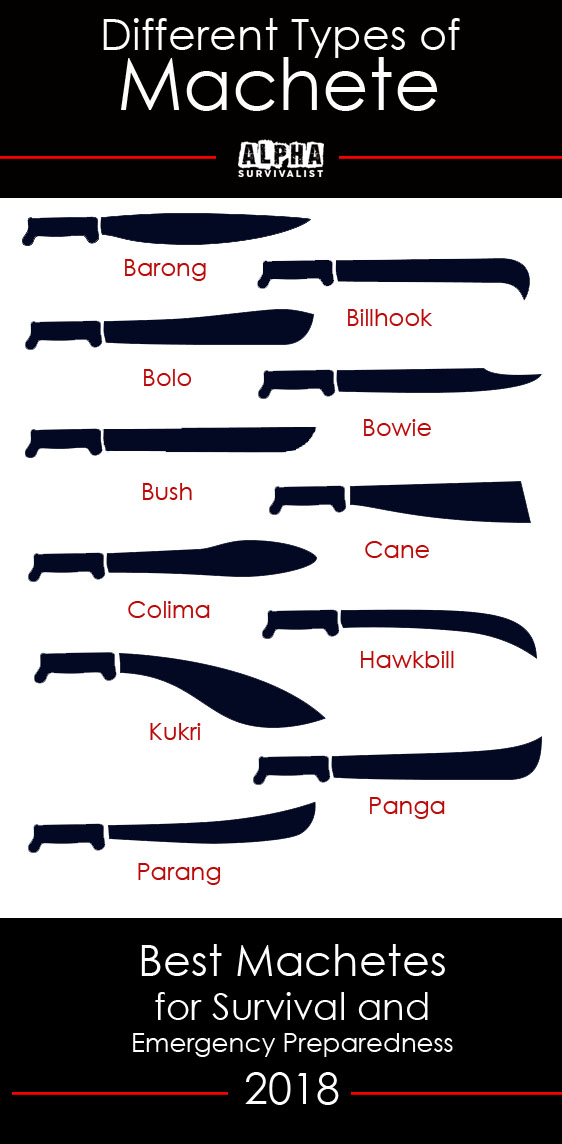
Because the World’s vegetation varies, machetes have had to be adapted to best suit the type of work required of them, this is why there are so many differences in machete size, shape, and weight, from one part of the world to another.
Machetes have different names and styles that are intrinsically linked to the locations where they originated, in some cases the same machete may even be known by different names in different areas.
Some styles are definitely better suited to certain types of work than others but as to which machete is the best is extremely subjective. As for which type of machete is best suited to the multi-purpose role of a Survival machete well again, that’s subjective, but you could always check out our post about the Best Machetes for Survival and read our view on it!
Here is a rundown of the best known machetes in the world, providing a little bit of information on each of them.
Barong Machete
A Culturally Important Tool Designed in the Southern Philippines
The barong machete features a single-edged blade that is designed as a weapon used primarily by Muslim Filipino groups in the Southern Philippines. The machete is intricately crafted with rounded edges and a pistol-shaped handle that is usually quite ornate and featuring a silver sleeve and fiber rings. Barong machetes belonging to Filipino noblemen in the 19th century were also designed with materials such as ivory and Philippine ebony.
The blade was primarily used by Filipino hunters once a wild animal was already shot down. These machetes typically had common copper and fiber hilts as well as metal sleeves in some cases. Ornate barong machetes were used by noble individuals as a sign of rank and power.
The Barong is often used for hunting, and slaughtering livestock and is also known as the Barung and Rawit.
>>Check out Barong Machetes Here<<
Billhook Machete
The Long History and Widespread Use of the Billhook Machete
Billhook machetes are traditionally made from carbon steel and originate in Asia and Europe as a common cutting tool. They are crafted primarily as agricultural cutting tools. Used by workers on the fields to clear paths, cut around objects and trees, or shedding – the process of removing buds and side shoots from a branch – it has a uniquely intricate shape that has remained pretty much the same for many centuries.
The hooked blade and the sharpened inner curve of the billhook machete has been known since ancient times, and was designed for gripping, cutting and managing vines more easily. The hilt can be wood, metal or plastic, depending on what it’s needed for and the amount of grip it requires. Also, today this machete design can be used for a variety of other purposes as well, such as cutting or maintaining hedges.
The billhook machete is also known as the Bagging Hook, Reaping Hook, Sheaf Hook, and Coa.
>>Check out Billhook Machetes Here<<
Bolo Machete
An Agricultural Tool Linked to South-Asian Combat
Originating in the Philippines, the bolo machete is a large, elongated cutting tool that was first used in the Philippines, Cuba and the Indonesian jungle, before knowledge of its design spread to Western cultures.
The native animal skin or hardwood handle is meant to maintain a strong grip, while the long steel blade that curves and widens is designed to offer users added momentum for cutting and chopping thicker plants and trees. When used for gardening, bolos typically have a more rounded tip, and they are also designed to be shorter, lighter and more manageable. There are also combat bolos that were crafted to be much larger, more similar to longer daggers and more difficult to handle, but also much more dangerous.
>>Check out Bolo Machetes Here<<
Bowie Machete
A Famous Blade with a Complex History
While the exact origins of the Bowie machete is shrouded in mystery, there are a few facts about its history that are very well-known: the knife was named after notorious knife fighter, James Bowie, its popularity peaked around the 1800s, and the knife’s origins were more or less lost in the 20th century due to misquoted documents and facts.
The Bowie knife has a unique shape featuring a straight blade ending in the sharp, thin and pointed tip that has made it famous. First designed to feature a common hilt and a blade about the same size as that of a basic carving knife, later versions of the machete are 8 or even 12 inches in length. The Bowie machete’s unique design makes it ideal for butchering meat, hunting game and engaging in armed combat.
The Bowie Machete is also known as the Large Bowie Knife, Survival Machete, and Wilderness Machete.
>>Check out Bowie Machetes Here<<
Bush Machete
Cutting Vegetation Made Into an Easy and Convenient Task
As the name implies, a bush machete is a much less aggressive tool than blades such as the Bowie machete or the aggressive Filipino-origin hunting machetes. The bush machete is designed primarily to be portable, light, easy to use and capable of cutting green vegetation or acting as a multi-purpose utility tool.
The machete is designed with an elongated blade that can reach lengths between 12 and 24 inches. Depending on what it’s designed to be used for, the knife’s hilt can be wood, plastic or featuring traditional or cross-guard designs. The gently thickened and rounded tip of the blade is made to offer ideal balance and momentum while making the long machete easier to handle.
Also referred to as a Latin-Style Machete.
>>Check out Bush Machetes Here<<
Cane Machete
A Traditional Tool Still Used in Many Parts of the World: the Cane Machete
The cane machete is a well-known tool that is still used today in areas where sugarcane is grown without the use of machines. In the Philippines, as well as countries like Peru, Brazil, Colombia, Cuba and Australia, as well as in some parts of the Southern United States, the use of the cane machete for sugarcane harvesting is particularly prevalent although it is also used to cut rice, bamboo, and corn stalks.
The deep blade and the hook at the end, as well as the thin, straight handle are some of the main characteristics that the cane machete is known for. The thing blade is made for easier and quicker cutting, while the hook exists to help pick up the cane once it’s cut.
The cane machete may also be referred to as the Corn Knife, Cleaver, Espading, or the Machete de Suelo.
>>Check out Cane Machetes Here<<
Colima Machete
Clearing Large Portions of Thick Vegetation with the Colima Machete
The Colima machete is one of the more unique and interesting machetes you will find. The blade is sharpened on both sides to facilitate a sweeping motion that can cut thick vegetation in both directions – which is precisely what it’s used for. Colima machetes also have a weighted rear side of the blade to facilitate an easier motion when clearing on the backstroke.
The Colima machete was widely used in areas fraught with thick jungles such as those in South and Central America. Aged Colima machetes originating in Guatemala, for instance, are known as some of the most intricate and finely crafted versions of the tool.
The Colima machete is often also called the Acapulqueno, Caguayano, Costeno, or Panzon
>>Check out Colima Machetes Here<<
Hawkbill Machete
The Curious Design and Widespread Use of the Hawkbill Machete
The hawkbill blade, also known as Cuma in some regions, is widely known due to its use in common pocket knives and combat knives used throughout the Western world for well over 100 years. Hawkbill machetes, however, have their own popularity as well. Designed to cut tall grasses, these knives are multi-purposed and capable of handling several cutting styles due to the unique configuration of both their sharpened sides.
Since the blade can be sharpened on both sides, the talon-like shape of the tip of a hawkbill machete’s elongated, 20-28 inch blade, is designed to ease you into the cut, so you only have to place a very small amount of downward pressure to make it. At the same time, the sharpened tip is designed to allow for easy stabbing and to act as a hook together with the inner curve, when collecting stalked vegetation.
>>Check out Hawkbill Machetes Here<<
Kukri
The Unique, Intricately Built, Multi-Purpose Machete from Nepal
The all-purpose Kukri is well-known throughout Southern and Central Asia. Originating in Nepal, it is also known as a Rawit or Gurkha blade. With a hilt that resembles that of an ordinary kitchen knife, the machete has a blade resembling a bent leaf or water droplet, with a larger center and thin, pointed tip and rear.
The purpose of this design is to facilitate stabbing, cutting and carving. The first is performed with the sharp tip, while the cutting is done with the longer exterior of the blade. The narrow area near the handle is primarily used for carving wood as well as for whittling.
>>Check out Kukri Machetes Here<<
Panga Machete
A Tool for Slicing Through Moderately Thick Vegetation
Anyone who lives in an area where the vegetation grows thick and resilient can benefit from the use of an African panga machete. These machetes originate in Africa, and their design is similar to parang and hawkbill machetes, except they are somewhat thicker and straighter.
The design became popular in the Caribbean during the 1700s, and was gradually adopted by locals and colonials who used the curvature of the blade to chop through moderately wooded, thick vegetation more easily. The pointed tip of the blade is also capable of concentrating an impressive amount of force into a single point for stabbing and piercing, making the panga an excellent tool for defending against attacks and wild animals while moving through an unknown territory.
Also known as; Burriquito, Daga, Liniero, and Rozador.
>>Check out Panga Machetes Here<<
Parang Machete
Indonesia’s Well-Known Machete for Cutting Woody Vegetation
Just as panga machetes have spread through the western world, parang machetes, originating in Indonesia, have gradually spread throughout Southern and Central Asia as a preferred tool for cutting through thick vegetation. Its distinctive curved shape is reminiscent of Turkish scimitars, but the curve is much less pronounced.
Because of their curved shape and significant length, parang machetes are remarkably effective at slicing through even the thickest and most robust woody stems without getting lodged into the material. Some designs can be somewhat more weighted to allow for greater momentum during strokes, while others are lighter and designed for moving through lighter vegetation and retaining their sharpness longer before having to be re-sharpened.
Other names for the Parang Machete are the Golok, Bedog, and Sable.

